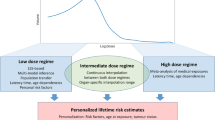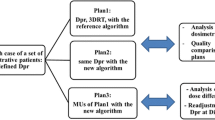Abstract
Estimates of secondary cancer risk after radiotherapy are becoming more important for comparative treatment planning. Modern treatment planning systems provide accurate three-dimensional (3D) dose distributions for each individual patient. The dose distributions can be converted into organ equivalent doses to describe radiation-induced cancer after radiotherapy (OEDrad-ther) in the irradiated organs. The OEDrad-ther concept assumes that any two dose distributions in an organ are equivalent if they cause the same radiation-induced cancer risk. In this work, this concept is applied to dose–response relationships, which are leveling off at high dose. The organ-dependent operational parameter of this dose–response relationship was estimated by analyzing secondary cancer incidence data of patients with Hodgkin’s disease. The dose distributions of a typical radiotherapy treatment plan for treating Hodgkin’s disease was reconstructed. Dose distributions were calculated in individual organs from which cancer incidence data were available. The model parameter was obtained by comparing dose and cancer incidence rates for the individual organs.

Similar content being viewed by others
References
Hall EJ. Henry S. (2004) The crooked shall be made straight; dose-response relationships for carcinogenesis (Kaplan Distinguished Scientist Award 2003). Int J Radiat Biol 80(5):327–337
Schneider U, Zwahlen D, Ross D, Kaser-Hotz B (2005) Estimation of radiation induced cancer from 3D-dose distributions: concept of organ equivalent dose. Int J Radiat Oncol Biol Phys 61:1510–1515
ICRP (1991) Recommendations of the international commission on radiological protection. Publication 60, Annals of the ICRP 21(1-3). Pergamon, Oxford
Schneider U, Kaser-Hotz B (2005) A simple dose-response relationship for modelling secondary cancer incidence after radiotherapy. Z Med Phys 15(1):31–37
Broerse JJ. (1999) Radiation induced cancer in animals. In: Baumstark-Khan C et al. (ed) Fundamentals for the assessment of risks from environmental radiation. Kluver, Dordrecht, pp. 379–388
Mole RH (1984) Dose-response relationships. In: Boice JD, Fraumeni JF (eds) Radiation carcinogenesis: epidemiology and biological significance. Raven, New York pp. 403–420
Hall EJ, Wuu CS (2003) Radiation-induced second cancers: the impact of 3D-CRT and IMRT. Int J Radiat Oncol Biol Phys 56(1):83–88
Davis RH (2004) Production and killing of second cancer precursor cells in radiation therapy. Int J Radiat Oncol Biol Phys 59(3):916
Schneider U (2005) Dose-response relationship for radiation-induced cancer-decrease or plateau at high dose. Int J Radiat Oncol Biol Phys 61(1):312–313
UNSCEAR (2000) Report to the general assembly, sources and effects of ionizing radiation, Volume II: Effects, Annex I: Epidemiological evaluation of radiation-induced cancer. http://www.unscear.org/reports/2000_2.html
Thomson D, Mabuchi K, Ron E, Soda M, Tokunaga M, Ochikubo S, Sugimoto S, Ikeda T, Terasaki M, Izumi S, Preston D (1994) Cancer incidence in atomic bomb survivors. Part II: Solid tumors, 1958-1987. Rad Res 137:S17–S67
van Leeuwen FE, Travis LB (2001) Second cancers. In: DeVita VT, Hellman S, Rosenberg SA (eds) Cancer: principles and practice of oncology, 6th edn. Lippincott Williams & Wilkins, Philadelphia, pp 2939–2964
Preston D, Shimizu Y, Pierce D, Suyama A, Mabuchi K (2003) Studies of mortality of atomic bomb survivors. Report 13: solid cancer and noncancer disease mortality: 1950-1997. Rad Res 160:381–407
van Leeuwen FE, Klokman WJ, Veer MB, et al (2000) Long-term risk of second malignancy in survivors of Hodgkin’s disease treated during adolescence or young adulthood. J Clin Oncol 18:487–497
Zubal IG, Harrell CR, Smith EO, et al. (1994) Computerized three-dimensional segmented human anatomy. Med Phys 21(2):299–302
Mauch PM, Leslie AK, Kadin M, et al. (1993) Patterns of presentation of Hodgkin disease. Cancer. 71(6):2062–2071
Hoppe RT (1990) Radiation therapy in the management of Hodgkin’s disease. Semin Oncol 17(6):704–715
Acknowledgement
The authors would like to express their appreciation to the editor Dr. Werner Rühm for his helpful comments and ideas during revision of this manuscript.
Author information
Authors and Affiliations
Corresponding author
Rights and permissions
About this article
Cite this article
Schneider, U., Kaser-Hotz, B. Radiation risk estimates after radiotherapy: application of the organ equivalent dose concept to plateau dose–response relationships. Radiat Environ Biophys 44, 235–239 (2005). https://doi.org/10.1007/s00411-005-0016-1
Received:
Accepted:
Published:
Issue Date:
DOI: https://doi.org/10.1007/s00411-005-0016-1




